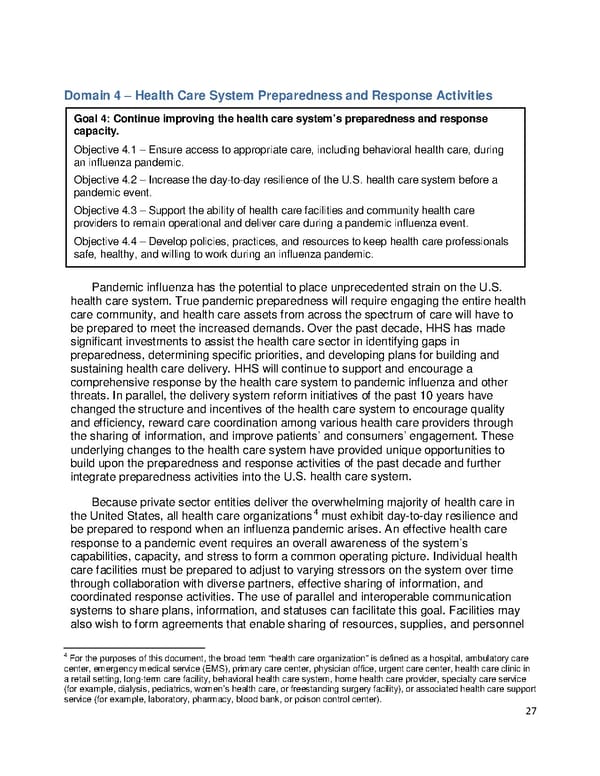Domain 4 – Health Care System Preparedness and Response Activities Goal 4: Continue improving the health care system’s preparedness and response capacity. Objective 4.1 – Ensure access to appropriate care, including behavioral health care, during an influenza pandemic. Objective 4.2 – Increase the day-to-day resilience of the U.S. health care system before a pandemic event. Objective 4.3 – Support the ability of health care facilities and community health care providers to remain operational and deliver care during a pandemic influenza event. evelop policies, practices, and resources to keep health care professionals Objective 4.4 – D safe, healthy, and willing to work during an influenza pandemic. Pandemic influenza has the potential to place unprecedented strain on the U.S. health care system. True pandemic preparedness will require engaging the entire health care community, and health care assets from across the spectrum of care will have to be prepared to meet the increased demands. Over the past decade, HHS has made significant investments to assist the health care sector in identifying gaps in preparedness, determining specific priorities, and developing plans for building and sustaining health care delivery. HHS will continue to support and encourage a are system to pandemic influenza and other the health c comprehensive response by threats. In parallel, the delivery system reform initiatives of the past 10 years have changed the structure and incentives of the health care system to encourage quality and efficiency, reward care coordination among various health care providers through the sharing of information, and improve patients’ and consumers’ engagement. These underlying changes to the health care system have provided unique opportunities to build upon the preparedness and response activities of the past decade and further integrate preparedness activities into the U.S. health care system. Because private sector entities deliver the overwhelming majority of health care in 4 the United States, all health care organizations must exhibit day-to-day resilience and be prepared to respond when an influenza pandemic arises. An effective health care response to a pandemic event requires an overall awareness of the system’s capabilities, capacity, and stress to form a common operating picture. Individual health care facilities must be prepared to adjust to varying stressors on the system over time through collaboration with diverse partners, effective sharing of information, and coordinated response activities. The use of parallel and interoperable communication systems to share plans, information, and statuses can facilitate this goal. Facilities may also wish to form agreements that enable sharing of resources, supplies, and personnel 4 For the purposes of this document, the broad term “health care organization” is defined as a hospital, ambulatory care center, emergency medical service (EMS), primary care center, physician office, urgent care center, health care clinic in a retail setting, long-term care facility, behavioral health care system, home health care provider, specialty care service (for example, dialysis, pediatrics, women’s health care, or freestanding surgery facility), or associated health care support service (for example, laboratory, pharmacy, blood bank, or poison control center). 27
 Pandemic Influenza Plan Page 26 Page 28
Pandemic Influenza Plan Page 26 Page 28